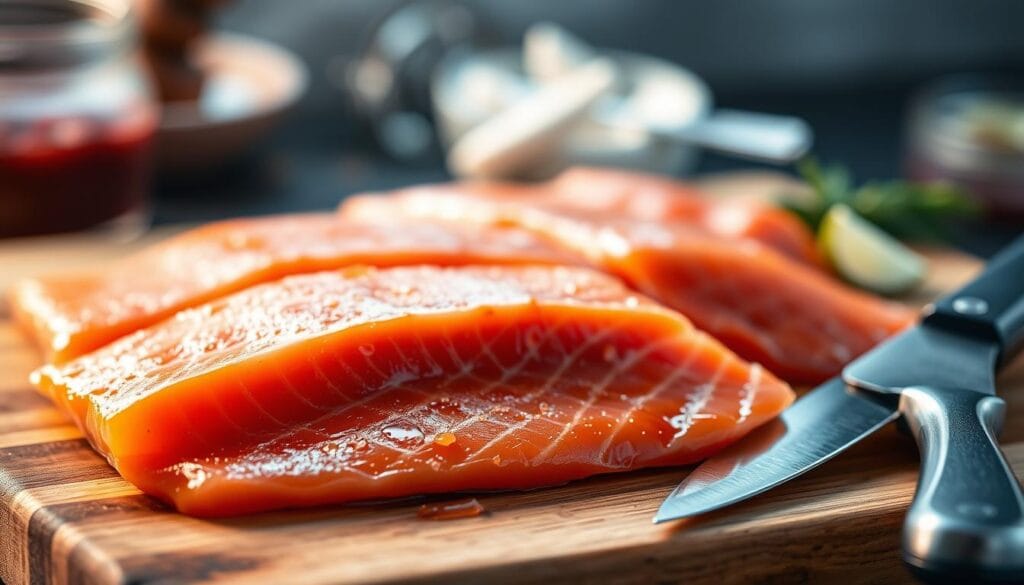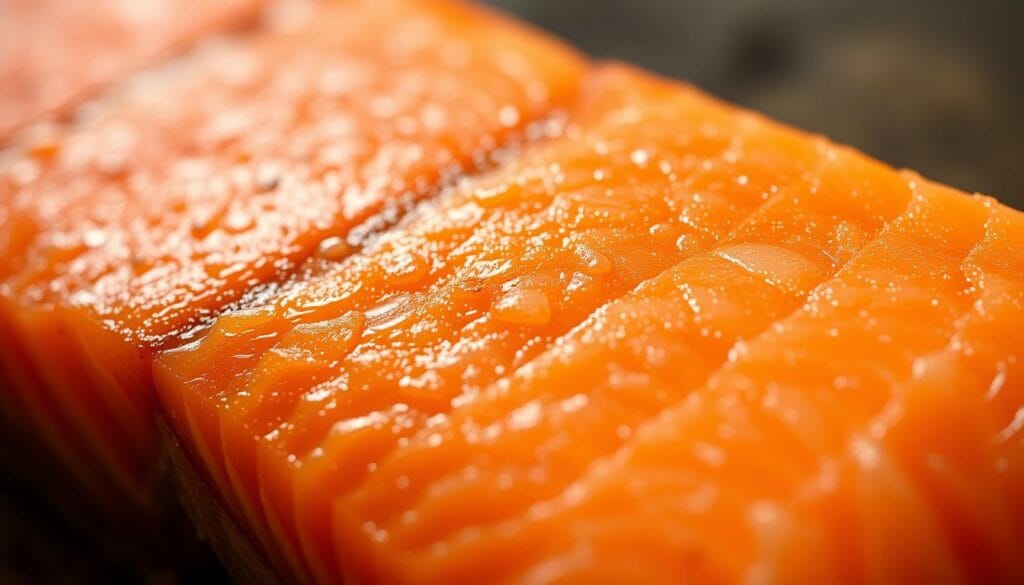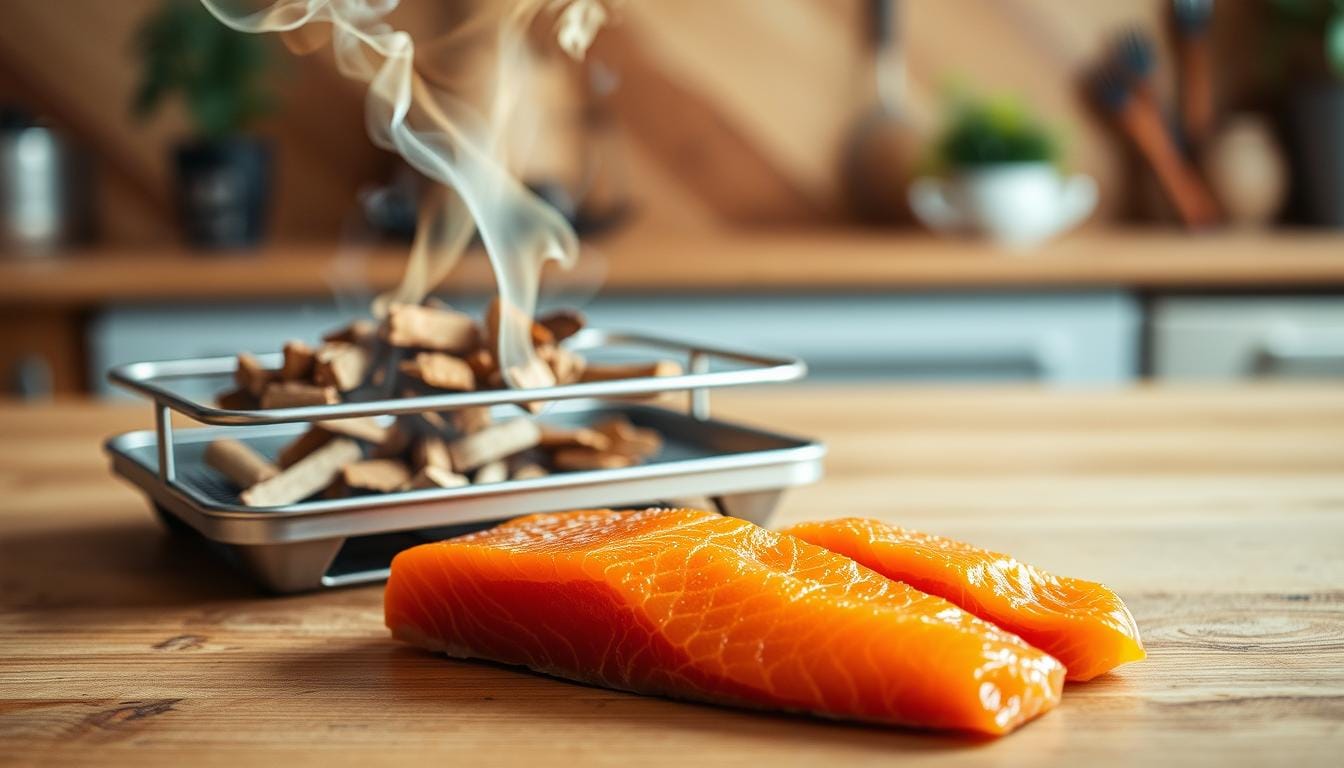How to Smoke Salmon Without a Smoker (No Special Gear Needed)
Table of Contents
The first time I learned to smoke salmon at home, it felt like a secret revealed. No need for a fancy smoker or special gear. Just pure, delicious flavor waiting to be made right on my countertop.
Learning to smoke salmon without a smoker is simpler than you think. With a few basic techniques and ingredients, you can turn ordinary fish into a gourmet dish. This guide will show you how to do it, whether you’re a home cook or just want that smoky flavor.
Smoking salmon at home is more than just following steps. It’s about creating something special with your own hands. You’ll learn how simple ingredients and creative methods can lead to amazing results. From different smoking styles to choosing the right salmon, this guide will help you become a home smoking pro.
Ready to dive into the art of smoking salmon without a smoker? Your culinary journey begins here.
Understanding Cold-Smoked vs Hot-Smoked Salmon
Exploring smoked salmon reveals two main methods: cold smoking and hot smoking. These methods create different flavors and textures. Knowing the differences helps you pick the right salmon for your next dish.
Hot Smoking Technique
Hot-smoked salmon is cooked at high temperatures. It reaches 120-180°F, making it fully cooked. This method gives:
- A flaky, fully cooked texture
- Intense smoky flavor
- Opaque, firm flesh
Cold Smoking Method
Cold smoked salmon is cured and dried, not cooked by heat. It’s not technically cooked, but it’s safe to eat. This method keeps the salmon’s texture silky and translucent.
Critical Temperature Distinctions
The temperature difference between these methods is key. Cold smoked salmon needs careful handling for safety. Producers use special curing to keep it safe and delicate.
Whether you like hot smoked’s strong flavor or cold smoked’s soft texture, knowing these methods will make your cooking better.
Choosing the Best Salmon for Smoking
When you’re learning to make smoked salmon, picking the right fish is key. The salmon you choose can change the taste, texture, and quality of your dish.
Not all salmon is the same. The type and quality of salmon you pick will affect your smoking process and the final product. Knowing your options helps you make a better choice.
Farm-Raised Atlantic Salmon
Farm-raised Atlantic salmon is a good choice for beginners. It’s consistent, easy to find, and has:
- Uniform fat content
- Mild, predictable flavor
- Lower cost than wild-caught options
Wild-Caught Options
Wild salmon adds something special to your smoking journey:
- More complex flavor profile
- Higher nutritional value
- Typically leaner meat
Quality Indicators to Look For
When picking salmon for smoking, look for these quality signs:
| Quality Indicator | What to Look For |
|---|---|
| Color | Bright, consistent pink or orange hue |
| Smell | Fresh, ocean-like aroma with no fishy odor |
| Texture | Firm, smooth surface without bruising |
Pro tip: Choose salmon that looks and smells fresh, no matter if it’s farm-raised or wild-caught. Your nose and eyes are the best tools when selecting fish for smoking.
Essential Ingredients and Equipment
Learning to smoke salmon without a smoker is simpler than you might think. You probably have most of what you need in your kitchen already. With a few basic tools and ingredients, you can make tasty smoked salmon at home.
To start, gather these key ingredients:
- Fresh salmon fillet
- Kosher salt
- Brown sugar
- Liquid smoke
- Black pepper
- Optional herbs and spices
You’ll also need some basic kitchen gear:
- Wire cooling rack
- Baking sheet
- Sharp fillet knife
- Plastic wrap
- Measuring spoons
The liquid smoke is key when you’re smoking salmon without a smoker. It adds a smoky flavor that’s hard to get without a wood smoker. Just a few drops can make your salmon taste rich and deep.
Pro tip: Choose high-quality, pure liquid smoke without additional artificial ingredients for the best results.
You don’t need special smoking gear. With these simple ingredients and tools, you can make smoked salmon that rivals what you’d find in a restaurant.
How to Smoke Salmon Without a Smoker
Making cold smoked salmon at home is easier than you might think. You don’t need special equipment to get a smoky flavor. This turns ordinary salmon into a gourmet treat. With a few simple steps, you can make it just like the pros in your kitchen.

The secret to great cold smoked salmon is knowing the right prep and flavor techniques. Your kitchen can be the perfect place for smoking salmon with some creative ideas.
Preparing the Dry Rub
Creating the perfect dry rub is key for cold smoked salmon. Your mix should include:
- Kosher salt
- Brown sugar
- Cracked black pepper
- Optional herbs like dill or thyme
Adding Liquid Smoke
Liquid smoke is a big help for home cooks wanting to smoke like pros. A few drops can really boost your salmon’s taste. Mix liquid smoke into your dry rub well to spread it evenly.
Alternative Smoking Methods
When you can’t use traditional smoking, there are other ways to get great results:
- Oven method with wood chips
- Tea smoking technique
- Stovetop smoking pan
- Indirect heat with smoky seasoning
Each method has its own way to add smoky flavors to your salmon. You don’t need fancy smoking gear to do it.
The Perfect Brine Recipe
Learning to make smoked salmon begins with the perfect brine. A well-made brine turns simple salmon into a tasty treat. It will wow even the pickiest seafood lovers.
The key to a great brine is finding the right mix of ingredients. When smoking salmon, the brine does two main things. It boosts flavor and keeps the salmon moist.
Essential Brine Ingredients
- Kosher salt (primary seasoning)
- Brown sugar (balances saltiness)
- Cold water (base liquid)
- Optional flavor enhancers:
- Garlic powder
- Black pepper
- Dried herbs
Start with a brine mix of about 1/4 cup kosher salt and 1/4 cup brown sugar per quart of water. This mix is perfect for making smoked salmon that’s both tasty and tender.
Brining Techniques
Here are key steps for brining salmon:
- Dissolve salt and sugar in cold water
- Put the salmon fully in the brine
- Keep it in the fridge while brining
- Brine time varies by fillet thickness:
- Thin fillets: 2-4 hours
- Thick fillets: 4-8 hours
Pro tip: Never brine salmon longer than 8 hours. It can get too salty and lose its softness.
Creating the Essential Pellicle
When making cold smoked salmon, creating a pellicle is key. This thin, sticky layer on the salmon’s surface is important. It helps in absorbing smoke and developing flavors.

The pellicle acts as a shield. It helps the smoke stick to the fish better. Without it, your salmon might not taste smoky enough.
Why Pellicle Formation Matters
Creating a good pellicle involves a few steps:
- Removing excess moisture from the salmon’s surface
- Allowing proteins to become sticky and tacky
- Preparing the fish for optimal smoke absorption
Drying Time Guidelines
To get a perfect pellicle for cold smoked salmon, follow these tips:
- Pat the salmon dry with paper towels
- Put the fish on a rack in the fridge
- Let it air dry for 2-4 hours
- Make sure air circulates well around the fish
The pellicle should feel slightly tacky but not wet. The salmon’s drying time can change with room temperature and humidity. Keep an eye on it during this important step.
Temperature Control and Cooking Time
Mastering temperature control is key when smoking salmon at home. Knowing if smoked salmon is raw or fully cooked is important. It helps you make a tasty and safe dish. The goal is to keep the temperature just right during smoking.
To smoke salmon well, keep the temperature between 225°F and 275°F. This range helps the salmon cook evenly and adds smoky flavors. Is smoked salmon raw? No, it’s not when cooked right – the right temperature makes it safe to eat.
- Wild salmon internal temperature target: 120°F
- Farm-raised salmon internal temperature target: 125°F
- Recommended smoker/oven temperature range: 225-275°F
Different salmon types need slightly different temperatures. Wild salmon cooks faster because it’s leaner. Farm-raised salmon might need a bit more time to reach the perfect temperature.
| Salmon Type | Target Internal Temperature | Cooking Time Estimate |
|---|---|---|
| Wild Salmon | 120°F | 45-60 minutes |
| Farm-Raised Salmon | 125°F | 60-75 minutes |
“Precision is the secret to perfectly smoked salmon” – Professional Chef Recommendation
Always use a meat thermometer to check the salmon’s internal temperature. This ensures it’s cooked right and safe to eat. Remember, salmon will keep cooking a bit after it’s removed from the heat. So, take it out just before it reaches the final temperature.
Signs of Perfectly Smoked Salmon
Mastering the art of making cold smoked salmon requires keen attention to detail. Knowing exactly when your salmon has reached perfection can transform your culinary experience from good to extraordinary.
When making cold smoked salmon, several key indicators help you determine if your fish has been prepared just right. Professional chefs and home cooks alike rely on specific visual, textural, and temperature cues to ensure optimal results.
Visual Signals of Quality
- Smooth, translucent surface with a rich salmon color
- No excessive white protein (albumin) deposits
- Consistent color throughout the fillet
- Glossy appearance indicating proper moisture retention
Texture Assessment
The texture of your cold smoked salmon speaks volumes about its preparation. A perfectly smoked salmon should have:
- Silky, buttery consistency
- Delicate flakiness when gently pulled apart
- Soft, tender meat that isn’t dry or tough
- Slight resistance when cutting, indicating proper curing
Temperature Verification
Internal temperature is key when making cold smoked salmon. Aim for:
- 120-125°F for medium-rare texture
- Use a reliable meat thermometer for accurate readings
- Check the temperature at the thickest part of the fillet
By carefully observing these indicators, you’ll create a cold smoked salmon that rivals professional preparations.
Conclusion
Learning to smoke salmon without a smoker opens up new culinary adventures. You’ve found out that making delicious smoked salmon is easy and doesn’t need fancy gear or special training. With what you’ve learned, you can turn simple salmon into a gourmet treat in your kitchen.
Smoked salmon is very flexible. You can eat it warm, at room temperature, or cold. Try it on bagels, in scrambled eggs, or on salads. Smoking salmon at home lets you control the taste and texture, making your dish just right.
Keeping your smoked salmon fresh is important. Wrap it well and keep it in the fridge for up to five days. Vacuum-sealing can help it last even longer. Every time you smoke salmon, you get better at it and enjoy the process more.
Keep improving your smoking skills and try different salmon types, seasonings, and methods. Your homemade smoked salmon will wow everyone. It shows that with a little creativity and basic tools, you can make food that looks and tastes like it came from a pro.
FAQ
Is cold-smoked salmon considered raw?
Can I smoke salmon without specialized smoking equipment?
What type of salmon is best for smoking?
How long does homemade smoked salmon last?
What’s the difference between hot and cold smoking?
Do I need liquid smoke to make smoked salmon?
How do I prevent my salmon from becoming too salty?
What safety precautions should I take when smoking salmon at home?
Did You Try Our Recipe?
There are no reviews yet. Be the first one to write one.

